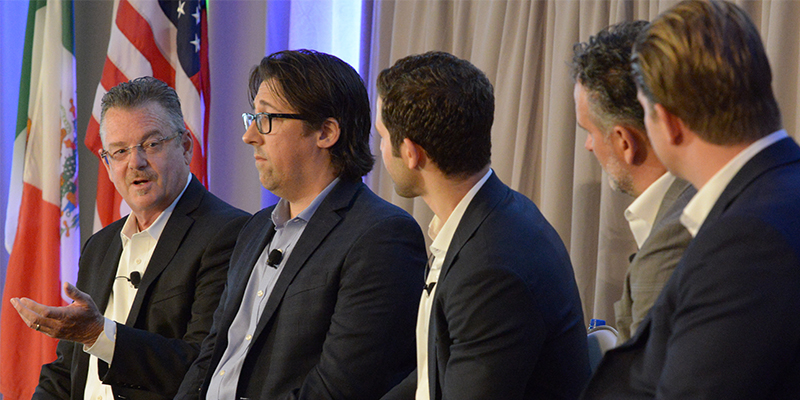At I.CON East 2019, the always-popular capital markets session was full of heavy-hitters who shared what they’re seeing in the market, strategies for investment, and their forecasts for the future. Andrew Briner, CCIM, managing director with JLL, moderated the panel, which included Brian Gagne, senior vice president, investments, real estate, Brookfield Asset Management; David Levine, managing director, Blackstone; Mario Morroni, executive vice president, industrial North America, Ivanhoe Cambridge; and Kim Snyder, president, Western region, Prologis.
In late 2018 and the first half of 2019, the economy experienced several hiccups; Brexit, the U.S. government shutdown, and trade talks led to some uncertainty in the markets. Briner asked the panel if they thought the dips in the market foretell a slowdown or recession, or of if the decrease in absorption was more of a market correction.
“I don’t think anyone in this room thinks industrial demand is slowing down, at least holistically,” Levine said. “Maybe in pockets of the country. I’d say net absorption slowing down is more so because there’s just less out there to absorb.”
“Retailers are very reactionary right now,” added Gagne. “All of these trade talks are impacting their business daily. But at the same time, if you look at the amount of cash from e-commerce companies – they are so ready to spend.”
“A lot of transactions – whether new leases or new starts – all felt that same reverberation of the ‘tapping of the brakes,’” said Snyder. “It’s picked back up despite the tariffs and the uncertainty, but I’d argue there’s still a bit of caution out there. People are thinking long and hard about their next move, and that caution is going to level things out. Maybe we’ll see a little slower growth than we would have thought at the beginning of this year.”
Briner brought up the Federal Reserve’s potential to further cut interest rates: What impact would that have on overall business sentiment and on overall real estate values?
“As investors, we’re always mindful of how interest rates are impacting investor spending,” said Morroni. “Debt is extremely cheap, even for a consumer – they’re not over-burdened with debt. As long as the consumer is spending and they have jobs, we’re in a good place.”
“Generally speaking, lower interest rates help real estate value, so that’s a good thing from an investment standpoint,” said Snyder. “If interest rates keep going down, are we going to reach a threshold at some point? I have no idea.”
Industrial is seeing previously unheard-of cap rates. Briner asked the panelists if the current pricing levels are sustainable.
“We’re naturally heading to unseen levels of cap rates,” said Morroni. “We’ve been challenging ourselves internally to understand that. But with the continued growth of e-commerce, I think supply and demand is pretty much in check.”
“We’re mindful of historical data,” added Levine, “but this is the most liquid asset class with the strongest fundamentals, and we don’t see that changing.”
“E-commerce represents a fundamental change in our business,” said Snyder. “It’s a strong tailwind that’s going to continue to strengthen our asset class. With these major structural changes in the business of consumption, I think our asset class is going to continue to see cap rate compression.”
Briner asked the panelists: When considering development, what are some of the key indicators you evaluate?
“We’re starting to pay more attention to labor pools,” said Morroni. “The market may look appealing, but if the labor is lacking, it’s going to be challenging there.”
“Our approach has been focused in five markets. We understand those are tighter spreads than if you go into secondary markets, but we feel a bit more comfortable building in a healthy market in areas where the vacancy around 1%,” said Levine.
“At this point in the cycle we are hyper-selective about location,” agreed Gagne.
Briner asked the panel about investing in the last mile, and the challenges as e-commerce and supply chain needs continue to evolve.
“A challenge, to use Los Angeles as an example, are areas where the population is so spread out and vast – it’s not dense,” said Snyder. “Part of what we’ve learned is you really have to know who you’re targeting. It’s really different community to community, and there’s a major opportunity for local developers who know their area.”
“We’re having conversations with our retail team to get creative,” said Gagne. “We’re looking at what we’re doing with our subterranean parking garages. Can we use part of a mall for a hybrid locker/e-commerce pick up?”
Morroni agreed: “We’re seeing how we can be creative with repurposing assets we already own in dense urban centers.’
Is it possible there’s too much money pouring into industrial? “What we really like about this sector is that developers have been pretty disciplined,” said Levine. “Construction costs continue to inflate, so you haven’t seen the level of oversupply we’ve seen before.”
“If you look at e-commerce penetration in this country compared to the United Kingdom and Asia,” Levine added, “We still believe we’re in the very nascent stages of what’s going on.”
This post is brought to you by JLL, the Social Media and Conference Blog sponsor of NAIOP’s I.CON East: The Industrial Conference. Learn more about JLL at www.us.jll.com or www.jll.ca.















